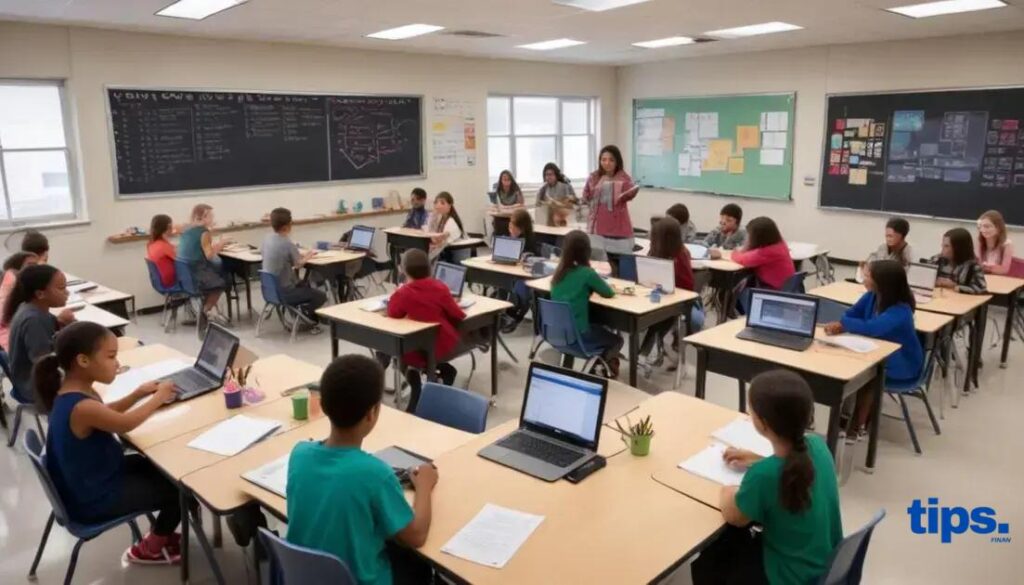Charter schools expansion: unlocking new opportunities

Anúncios
Charter schools are independently operated public schools that provide alternative educational options, emphasizing personalized learning and innovative teaching, while facing unique challenges such as funding disparities and regulatory hurdles.
Charter schools expansion is changing the landscape of education. With increasing options for parents and students, it raises questions about quality and access. Are these schools the solution to some of our current educational challenges? Let’s dive into what this means for our students and communities.
Anúncios
Understanding charter schools: what are they?
Charter schools are publicly funded but operate independently of the traditional public school system. They offer unique opportunities for both students and educators, enabling them to implement innovative teaching methods.
Understanding the basic principles of charter schools can help parents and communities make informed decisions about education.
Key Features of Charter Schools
Charter schools aim to improve educational outcomes by providing greater flexibility and accountability. Here are some of their main characteristics:
Anúncios
- They operate under charters that outline their educational goals and methods.
- Charter schools often have more freedom to design their curriculum and teaching practices.
- They are subject to performance-based accountability, which can lead to closure if they do not meet specific standards.
For more detailed insight into what charter schools are, you can visit the U.S. Department of Education’s charter schools page.
The growth of charter schools in recent years
In recent years, the number of charter schools has significantly increased across the United States. This growth reflects a rising demand for educational choices among parents and communities.
According to the National Alliance for Public Charter Schools, many families are opting for charter schools due to their potential to offer unique curricula and approaches to teaching.
Trends in Charter School Growth
Factors contributing to the expansion of charter schools include:
- The increasing focus on educational innovation and flexibility.
- A rising enrollment of students seeking alternatives to traditional public schools.
- Support from various organizations and policymakers advocating for school choice.
The expansion of charter schools also reflects shifts in educational policy, as more states enact laws to support their establishment. For further details on this trend, you can refer to the National Alliance for Public Charter Schools.
Key benefits of charter schools for students
Charter schools offer a unique educational experience that can provide several advantages for students. One of the most notable benefits is the opportunity for a more tailored learning environment.
Flexibility in Curriculum allows charter schools to develop specialized programs that meet the needs of their students. This might include enhanced arts education, STEM-focused curriculum, or language immersion programs.
div style=”width: 100%; padding: 10px; box-sizing: border-box;”>
| Aspect | Purpose | Example/Detail |
|---|---|---|
| Definition | Public schools with independent operations | Operate under specific charters |
| Growth | Rising demand for school choice | More schools nationwide |
| Benefits | Offer innovative and flexible education | Smaller classes, unique curricula |
| Challenges | Face funding gaps and strict regulations | Less funding than traditional schools |
| Community Impact | Strengthen local engagement and economy | Jobs, partnerships, family involvement |
| Comparison | Contrast with traditional public schools | Flexible curriculum, lottery admission |
| Future Trends | Focus on innovation and equity | Tech use, diverse student needs |
| Success Stories | Highlight effective models | KIPP, Success Academy, Green Dot |
Advantages of Attending a Charter School
Here are some key benefits that charter schools can provide for students:
- Individualized Learning: Smaller class sizes often lead to more personalized attention from teachers.
- Innovative Teaching Methods: Charter schools frequently experiment with different pedagogical approaches, making learning more engaging.
- Greater Parental Involvement: Many charter schools encourage parental engagement in school activities and decision-making processes.
For detailed insights into how charter schools can benefit students, check the Charter Schools USA website.
Challenges faced by charter schools

While charter schools offer many benefits, they also face significant challenges that can impact their effectiveness. Understanding these challenges is essential for parents and educators.
One major issue is the funding structure. Charter schools often receive less funding per student compared to traditional public schools. This can limit resources and staffing.
Common Challenges for Charter Schools
Some specific challenges include:
- Regulatory Issues: Charter schools must navigate various state regulations, which can limit their flexibility.
- Enrollment Variability: Fluctuating enrollment numbers can affect funding and resource allocation.
- Public Perception: Misunderstandings about charter schools can lead to negative perceptions, impacting community support.
For comprehensive information about the challenges charter schools face, you can refer to the National Charter School Network.
How charter schools impact local communities
Charter schools can have a profound effect on their local communities. They often create a sense of community engagement among families and local organizations.
By providing diverse educational options, charter schools can address the specific needs of various populations, which improves educational outcomes.
Positive Impacts of Charter Schools on Local Communities
Some notable ways in which charter schools influence their communities include:
- Economic Growth: Charter schools can stimulate local economies by creating jobs and attracting families who might contribute to the area.
- Increased Educational Options: They provide families with alternative education paths, which can enhance student achievement.
- Community Involvement: Many charter schools foster partnerships with local businesses, nonprofits, and universities, promoting collaboration within the community.
For further insights on how charter schools impact communities, you can visit the Charter School Research Center.
Comparative analysis: charter schools vs. traditional schools
Comparing charter schools and traditional public schools helps to highlight the differences in educational approaches and outcomes. Each type of school has unique features that cater to diverse student needs.
Charter schools are often characterized by their flexibility in curriculum and teaching methods, while traditional schools usually follow state mandates.
Key Differences Between Charter Schools and Traditional Schools
Here are some critical factors to consider:
- Funding: Charter schools are typically funded through a mix of state and local tax dollars, while traditional schools receive funding primarily from local property taxes.
- Curriculum: Charter schools can create specialized curricula that may focus on specific areas, like STEM or arts, whereas traditional schools must adhere to state standards.
- Enrollment: Charter schools may have a lottery system for admitting students, while traditional schools generally serve students based on geographic boundaries.
For a deeper understanding of the differences and similarities, you can check the Education Week website.
Future trends in charter schools expansion
The future of charter schools is promising, with several trends indicating continued growth and innovation. As education evolves, charter schools are adapting to meet new demands.
One notable trend is the increasing adoption of technology in the classroom. Charter schools are often more flexible in incorporating digital tools into their teaching methods.
Emerging Trends in Charter School Expansion
Here are some key trends shaping the future of charter schools:
- Personalized Learning: More charter schools are focusing on individualized education plans that cater to each student’s unique needs.
- Increased Collaboration: Partnerships with local businesses and educational institutions are becoming more common, enriching student experiences.
- Focus on Diverse Populations: Charter schools are increasingly created to serve specific communities and address unique educational challenges.
For additional insights into future trends in charter school expansion, visit the Charter School Research Center.
Case studies of successful charter schools

Examining case studies of successful charter schools provides valuable insights into effective practices and strategies. These examples showcase how charter schools can thrive while meeting the needs of their students.
Many successful charter schools have implemented innovative programs that enhance student engagement and performance.
Examples of Successful Charter Schools
Here are some notable case studies:
- Success Academy: Located in New York City, this network of charter schools emphasizes a rigorous curriculum and strong teacher training, leading to high student achievement.
- KIPP (Knowledge Is Power Program): KIPP schools focus on character development along with academic rigor, resulting in improved outcomes for students from low-income backgrounds.
- Green Dot Public Schools: This organization transforms struggling schools into high-performing charter schools through strong community involvement and a focus on college readiness.
For more information on successful charter school initiatives, visit the Charter School Research Center.
In summary, the impact of charter schools
Charter schools play an essential role in the education landscape, offering innovative learning options for students and families. They provide unique benefits, such as personalized learning and community involvement.
While these schools face challenges, many have found creative solutions that lead to successful outcomes. Case studies of various charter schools show how they have been able to achieve high levels of student achievement.
As we look to the future, the growth and expansion of charter schools will continue to shape our educational system, offering more choices and opportunities for students.
Understanding the differences between charter schools and traditional schools helps inform families and communities as they navigate educational options.
FAQ – Frequently Asked Questions about Charter Schools
What are charter schools?
Charter schools are publicly funded schools that operate independently of the traditional public school system, allowing for more flexibility in curriculum and teaching methods.
What are the benefits of charter schools for students?
Charter schools offer personalized learning, innovative teaching methods, and often foster greater parental involvement, which can lead to improved student outcomes.
How are charter schools funded?
Charter schools are funded through a mix of state and local tax dollars, but they usually receive less funding per student compared to traditional public schools.
What challenges do charter schools face?
Charter schools face challenges such as funding disparities, regulatory issues, and public perception, which can impact their operations and enrollment.





